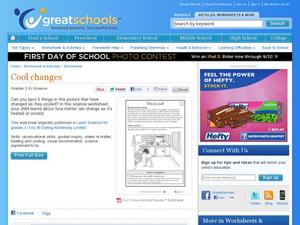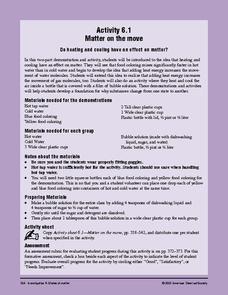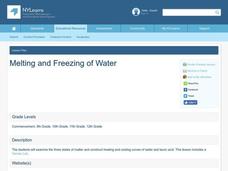Curated OER
The Urban Heat Island Effect - Lesson 2 (Grade 5)
Fifth graders use the scientific process to examine how when various surfaces are exposed to similar environmental conditions, surface temperatures may vary. They conduct an experiment to show the relationship between surface and...
Curated OER
Heating and Cooling a Really Large Lizard
Students investigate the effect of temperature on cold-blooded animals, using a 5 x 8 inch index card to represent a dinosaur as their model organism. Students measure temperature changes that occurs at different angles to a light...
Curated OER
What happens When Air is Heated or Cooled?
In this pressure worksheet, students write down their observations of a can placed into hot water. They explain what happens to the air molecules and the pressure inside the bottle which causes it to collapse.
Curated OER
Matter and Heat
Students examine how heating causes substances to expand, and cooling cause it to contract. They investigate the states of matter.
Curated OER
Matter Matters!
Second graders experiment with heating and cooling and research the states of matter (solid, liquid, gas).
Curated OER
This is Cool!
Third and fourth graders who are studying states of matter will enjoy this simple exercise. In it, they look at a picture of a girl in her kitchen, and they must circle five examples of materials that have changed states of matter as...
American Chemical Society
Matter on the Move
Start this mini unit on matter out by demonstrating how food coloring behaves when placed in cold and in hot water. Then have the class experiment with warm water and soap film. Pupils will learn that an increase in thermal energy also...
Curated OER
TE Activity: Hot Cans and Cold Cans
Students work on problems in which they investigate conduction, convection, and radiation. They attempt to maintain the warmth in one can of soda while cooling the other as much as possible in a thirty minute period. They examine how...
Curated OER
Hot and Cold Colors
Students explore the effect of heating and cooling on the dispersal of food coloring in water.
Curated OER
Keeping Warm
Learners participate in an online activity to determine how objects heat and cool. They determine what objects best serve as thermal insulators.
Curated OER
Melted Paintings
Another in the amazing series of lesson plans which use unique mediums! Students execute artwork on a non-traditional painting surface. They theorize what happen to their artwork if it is exposed to heat, then see what happens when they...
Curated OER
Melting and Freezing Behavior
Students investigate melting and freezing behavior in substances. For this melting and freezing points lesson plan, students perform experiments to test the impact of various salts on the freezing point of water, they test the impact of...
Concord Consortium
Boiling Point
Is it getting hot in here? Observe boiling from inside a beaker in an engaging interactive. Chemistry scholars heat and cool polar and non-polar solids and observe how molecules react to temperature changes. Your class' misconceptions...
Beyond Benign
Sublimation
Ah, caffeine! What would some of us do without it? Teach your high school chemistry class the concept of sublimation as they complete a hands-on experiment to visualize the changes caffeine undergoes during heating and cooling. They...
Virginia Department of Education
Charles’ Law
Searching for a relatively interesting way to demonstrate Charles' Law? Here is a instructional activity in which pupils heat air inside a flask and then cool the flask to quickly cool the air. They make observations about what occurs...
US Department of Energy
Thermodynamics—Teacher Guide
I'm so cool! No, you're exothermic. This thermodynamics lab unit includes an introduction, teacher demonstrations, six labs that students rotate through each class day, homework assignments, application of knowledge, and assessments....
Curated OER
Melting and Freezing of Water
High schoolers examine the three states of matter. They identify the segments of heating and cooling curves. Students analyze data and create a graph to determine the freezing and melting temperature of water.
Mr. E. Science
Thermal Energy and Heat
The presentation covers Fahrenheit, Celsius, and Kelvin scales for temperature as well as conduction, convection, and radiation.
Curated OER
Heat of Combustion Lab
In this heat of combustion lab, students measure the heat of combustion for paraffin wax, butane, and cheetos. Students will apply the 1st law of thermodynamics to calculate the heat lost by the fuel and the heat gained by the water to...
Curated OER
Weather and Oceans: Uneven Heating of the Earth
Students investigate what causes the heat on Earth. In this Earth heating instructional activity, students experiment with different heat sources and determine where the Earth gathers the most heat. Students explore vocabulary words...
Curated OER
Keeping Warm
Young scholars experiment with thermal insulators. In this heat transfer lesson, students predict and then measure heat loss from a cup of water using different materials as insulators. Young scholars complete a line graph to display...
Curated OER
Land and Sea Breezes
In this specific heat worksheet, students read about the land and sea breezes along the coast and how the specific heat of the air cause the differences in land and sea air creating breezes. Students answer three critical thinking...
Curated OER
Why Does a Puddle Shrink?
Fourth graders describe the relationship between heat energy, evaporation and condensation of water on Earth. They compare evaporation rates when the back of the hand and an equal area of a paper towel are moistened with the wet swab.
Curated OER
Heating
Students develop the idea that heat is a form of energy which moves from hot objects to cold ones.

























